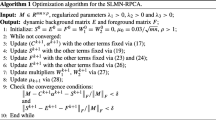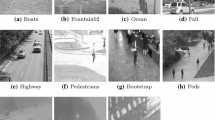Abstract
Background modeling plays an important role in many applications of computer vision such as anomaly detection and visual tracking. Most existing algorithms for learning appearance model are vector-based methods without maintaining the 2D spatial structure information of objects in an image. To this end, a robust tensor subspace learning algorithm is developed for background modeling which can capture the appearance changes through adaptively updating the tensor subspace. In the tensor framework, the spatial structure information is maintained and utilized for feature extraction of objects. Then by incorporating the robust scheme, we can weight individual pixel of an image to reduce the influence of outliers on background modeling. Furthermore an incremental algorithm for the robust tensor subspace learning is proposed to adapt to the variation of appearance model. The experimental results illustrate the effectiveness of the proposed robust learning algorithm for anomaly detection.







Similar content being viewed by others
Explore related subjects
Discover the latest articles, news and stories from top researchers in related subjects.References
He X, Cai D, Niyogi P (2005) Tensor subspace analysis. In: Proceedings of the Conference on Advance in Neural Information Processing Systems, pp 1–8
Li X, Hu W, Zhang Z, Zhang X, Luo G (2007) Robust visual tracking based on incremental tensor subspace learning. In: Proceedings of the 11th International Conference on Computer Vision, pp 1–8
Li Y, Xu L, Morphett J, Jacobs R (2004) On incremental and robust subspace learning. Pattern Recognit 37(7):1509–1518
Oliver N, Rosario B, Pentland AP (2000) A Bayesian computer vision system for modeling human interactions. IEEE Trans Pattern Anal Mach Intell 22(8):831–841
Ross D, Lim J, Lin R, Yang M (2008) Incremental learning for robust visual tracking. Int J Comput Vis 77(1–3):125–141
Skocaj D, Leonardis A (2003) Weighted and robust incremental method for subspace learning. In: Proceedings of the 9th IEEE International Conference on Computer Vision, pp 1494–1501
Sun J, Tao D, Faloutsos C (2006) Beyond streams and graphs: dynamic tensor analysis. In: Proceedings of the 12th ACM SIGKDD International Conference on Knowledge Discovery and Data Mining, pp 374–383
Tao D, Song M, Li X, Shen J, Sun J, Wu X, Faloutsos C, Maybank SJ (2008) Bayesian tensor approach for 3-D face modeling. IEEE Trans Circuits Syst Video Technol 18(10):1397–1410
Torre F, Black M (2003) A framework modeling for robust subspace learning. Int J Comput Vis 54(1–3):117–142
Wang Z, Bovik A, Sheikh H, Simoncelli E (2004) Image quality assessment: from error visibility to structural similarity. IEEE Trans Image Process 3(4):600–612
Wen J, Gao X, Li X, Tao D (2009) Incremental learning of weighted tensor subspace for visual tracking. In: Proceedings of the 2009 IEEE International Conference on Systems, Man, and Cybernetics, pp 3788–3793
Wen J, Gao X, Yuan Y, Tao D, Li J (2010) Incremental tensor biased discriminant analysis: a new color-based visual tracking method. Neurocomput 3(4–6):827–839
Vasilescu M, Terzopoulos D (2003) Multilinear subspace analysis of image ensembles. In: Proceedings of the 2003 IEEE International Conference on Computer Vision and Pattern Recognition, pp 93–99
Xu L, Yuille A (1995) Robust principal analysis by self-organizing rules based on statistical physics approach. IEEE Trans Neural Netw 6(1):131–143
Acknowledgements
We want to thank the helpful comments and suggestions from the anonymous reviewers. This research was supported partially by the National Natural Science Foundation of China under Grant 60832005; by the Ph.D. Programs Foundation of Ministry of Education of China under Grant 20090203110002; by the Key Science and Technology Program of Shaanxi Province of China under Grant. 2010K06-12; and by the Natural Science Basic Research Plan in Shaanxi Province of China under Grant 2009JM8004.
Author information
Authors and Affiliations
Corresponding author
Rights and permissions
About this article
Cite this article
Li, J., Han, G., Wen, J. et al. Robust tensor subspace learning for anomaly detection. Int. J. Mach. Learn. & Cyber. 2, 89–98 (2011). https://doi.org/10.1007/s13042-011-0017-0
Received:
Accepted:
Published:
Issue Date:
DOI: https://doi.org/10.1007/s13042-011-0017-0




